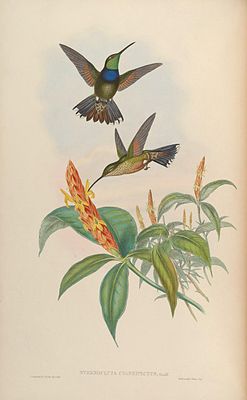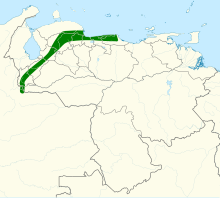Violet breasted hummingbird
| Violet breasted hummingbird | ||||||||||
|---|---|---|---|---|---|---|---|---|---|---|

Violet breasted hummingbird |
||||||||||
| Systematics | ||||||||||
|
||||||||||
| Scientific name of the genus | ||||||||||
| Sternoclyta | ||||||||||
| Gould , 1858 | ||||||||||
| Scientific name of the species | ||||||||||
| Sternoclyta cyanopectus | ||||||||||
| ( Gould , 1846) |
The violet- breasted hummingbird ( Sternoclyta cyanopectus ) is a species of hummingbird from the monotypic genus Sternoclyta . It occurs in Venezuela .
description
The violet breasted hummingbird reaches a length of 12 to 13 centimeters. The weight is 8.4 to 9.4 grams for the males and 9.0 to 10.3 grams for the females. The black beak is slightly curved. The upper side of the male is shimmering grass-green. The throat is glittering emerald green. The breast is characterized by a teardrop-shaped, glittering purple-blue spot. The rest of the underside is beige-gray with gold-green lamellas on the flanks. The tail is bronze green. The upper side of the female is colored like the male. The underside is gray-white with gold-green lamellae. The middle of the abdomen is reddish. The immatures resemble the females.
Occurrence and habitat
The violet-breasted hummingbird inhabits the Andean region in the Cordillera de Mérida in the Venezuelan states of Táchira , Mérida and Lara as well as the Cordillera de la Costa Central in Miranda . Its habitat is wet forests and woodland but also secondary forests and coffee plantations in the lower subtropical zone from sea level to an altitude of 1900 m. Occasionally it is also found in rainforests or cloud forests in the tropical zone.
Way of life
The violet- breasted hummingbird feeds on the nectar of the heliconia flowers. The clutch consists of two eggs that are incubated by the female.
Etymology and history of research
John Gould first described the violet- breasted hummingbird under the name Trochilus (Lampornis) cyanopectus . He named Venezuela as the site. When he introduced the new genus Sternoclyta with the delivery of 16 of his hummingbird tablets , he suggested the species. This name is derived from the Greek words »sternon, στερνον « for »breast« and »klutos, κλυτος « for »splendid, brilliant«. »Cyanopectus« is a structure from the Latin words »cyanos« for »shiny blue, lapis lazuli « and »pectus« for »breast«.
literature
- J. Del Hoyo, A. Elliot, J. Sargatal (Eds.) (1999): Handbook of the Birds of the World . Volume 5: Barn-Owls to Hummingbirds. Lynx Edicions. ISBN 8487334253
- James A. Jobling: Helm Dictionary of Scientific Bird Names . Christopher Helm, London 2010, ISBN 978-1-4081-2501-4 .
- John Gould: On twenty new species of Trochilidae or Humming-birds . In: Proceedings of the Zoological Society of London . tape 14 , no. 164 , 1846, pp. 85-90 ( online [accessed August 19, 2014]).
- John Gould: A monograph of the Trochilidæ, or family of humming-birds . tape 2 , delivery 16. Taylor and Francis, London 1858 ( online [accessed August 19, 2014]).
- Frederick Herschel Waterhouse: The dates of publication of some of the zoological works of the late John Gould, FRS RH Porter, London 1885 ( online [accessed August 19, 2014]).
Web links
- Sternoclyta cyanopectus inthe IUCN Red List of Threatened Species 2014.2. Listed by: BirdLife International, 2012. Retrieved August 19, 2014.
- BirdLife International: Species Factsheet - Violet-chested Hummingbird ( Sternoclyta cyanopectus ) . Retrieved August 19, 2014.
- Videos, photos and sound recordings of Violet-chested Hummingbird (Sternoclyta cyanopectus) in the Internet Bird Collection
- Violet Breasted Hummingbird ( Sternoclyta cyanopectus ) at Avibase; Retrieved August 19, 2014.
- Sternoclyta cyanopectus in the Integrated Taxonomic Information System (ITIS). Retrieved August 19, 2014.
- xeno-canto: Sound recordings - Violet-chested Hummingbird ( Sternoclyta cyanopectus )
- Violet- breasted hummingbird (Sternoclyta cyanopectus) in the Encyclopedia of Life . Retrieved September 8, 2017.

